- Joined
- Feb 2, 2011
- Messages
- 2,093
NEW RELEASES FOR MAY 2024
THE EIGHTEENTH CENTURY COLLECTION
THE AMERICAN WAR OF INDEPENDENCE 1775 – 1783
THE BATTLE OF COWPENS, JANUARY 17[SUP]th[/SUP], 1781.
THE 7[SUP]th[/SUP] REGIMENT OF FOOT (ROYAL FUSILIERS.)
The Battle of Cowpens was an engagement during the American Revolutionary War fought on January 17[SUP]th[/SUP] 1781, near the town of Cowpens, South Carolina, between American forces under Brigadier General Daniel Morgan, and British forces under Lieutenant Colonel Banastre Tarleton, as part of the campaign in the Carolinas.
The battle was a turning point in the American reconquest of South Carolina from the British.
Tarleton’s force of 1,000 British troops were set against 2,000 troops under Morgan. Morgan’s forces suffered casualties of only 25 killed and 124 wounded. Tarleton’s force was almost completely eliminated with almost 30% casualties and 55% of his force captured or missing, with Tarleton himself and only about 200 British troops escaping.
Morgan’s forces conducted a double envelopment of the British forces, the only double envelopment of the war.
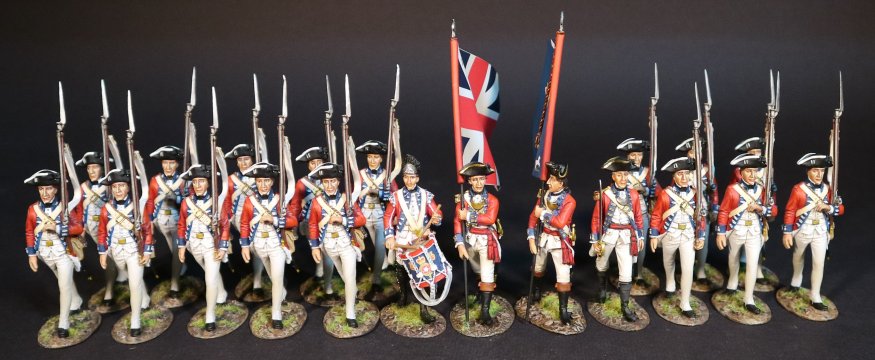
The Royal Fusiliers (city of London Regiment) was a line infantry regiment of the British Army which has been in continuous existence for 283 years. It was known as the 7[SUP]th[/SUP] Regiment of Foot until the Childers Reforms in 1881.
In 1747 the regiment was known as the Royal English Fuziliers and was given the precedence of 7[SUP]th[/SUP] in the Infantry of the Line. On 1[SUP]st[/SUP] July 1751 it was redesignated as the 7[SUP]th[/SUP] Regiment of Foot (Royal Fusiliers).
When county titles were added in August 1782 the subtitle (Derbyshire) was added, but this was never used and was later given to a different regiment.
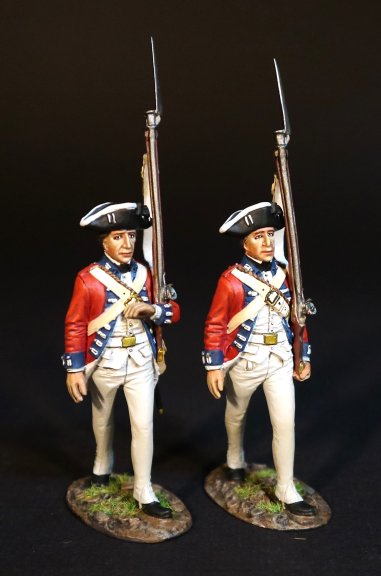
CW7FL-05
THE AMERICAN WAR OF INDEPENDENCE 1775-1783,
THE BATTLE OF COWPENS, JANUARY 17[SUP]th[/SUP] 1781,
7[SUP]th[/SUP] REGIMENT OF FOOT (ROYAL FUSILIERS.)
(2 pcs)
The Royal Fusiliers were sent to Canada in April 1773. The regiment was broken up into detachments that served at Montreal, Quebec, Fort Chambly and Fort St. Johns. In the face of the American invasion of Canada in 1775/76, the 80 man garrison of Fort Chambly attempted to resist a 400 man Rebel force but ultimately had to surrender, losing its regimental colours as a result. The bulk of the regiment was captured when St. John’s fell.
A 70 man detachment under the command of Captain Humphrey Owens assisted with the Battle of Quebec in December 1775.
The men taken prisoner during the defence of Canada were exchanged in British held New York city in December 1776. Here the regiment was rebuilt and garrisoned New York and New Jersey. In October 1777, the 7[SUP]th[/SUP] participated in the successful assaults on Fort Clinton and Fort Montgomery and the destruction of enemy stores at Continental Village. In late November, 1777 the regiment reinforced the garrison of Philadelphia. During the British evacuation back to New York city, the regiment participated in a diversionary raid in the days leading up to the Battle of Monmouth in June 1778.
In April 1780, the Royal Fusiliers took part in the capture of Charleston. Once Charleston fell, the regiment helped garrison the city. Three companies were sent to Ninety-Six to assist with the training of Loyalist militia companies. An 80 man detachment was also sent to Camden, South Carolina to help build that town’s defences. The detachments were recalled to Charleston for refitting in late August 1780.
The 7[SUP]th[/SUP], mounted on horses, along with the two regiments of Loyalist militia, cleared the region north of Georgetown, South Carolina of partisans while en route. The Royal Fusiliers turned the horses over to Lieutenant Colonel Banastre Tarleton’s British Legion upon uniting with Cornwallis in late September and then served as the Army’s rearguard.
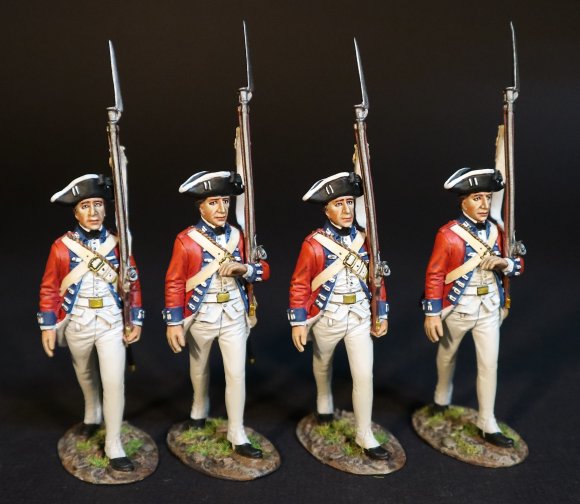
CW7FL-05N
THE AMERICAN WAR OF INDEPENDENCE 1775-1783,
THE BATTLE OF COWPENS, JANUARY 17[SUP]th[/SUP] 1781,
7[SUP]th[/SUP] REGIMENT OF FOOT (ROYAL FUSILIERS.)
(4 pcs)
Between October 1780 and early 1781, the regiment, having lost about one third of its officers and men to sickness and disease, protected the communication and supply lines between Camden and Winnsboro, South Carolina. On 7[SUP]th[/SUP] January, 1781, a contingent of 171 men from the Royal Fusiliers was detached from Cornwallis’s Army and fought under the command of Tarleton at the Battle of Cowpens in January 1781.
The Royal Fusiliers were on the left of the line of battle: Tarleton was defeated and the regiment’s colours were once again captured, and stored in the baggage wagons.
A 19 man detachment from the regiment fought through North Carolina participating in the Battle of Guilford Court House in March 1781 and ultimately the siege of Yorktown, where it served with the regiment’s Light Infantry Company. There was another detachment, composed largely of men recovered from the hospitals and recruits, which remained in the South under the command of Lt. Col. Alured Clarke. These men remained in garrison in Charleston, until they were transferred to Savannah, Georgia in December 1781.
The regiment returned to England in 1783.
THE QUEEN’S RANGERS (1[SUP]st[/SUP] AMERICAN REGIMENT) 1778-1783
SIMCOE’S RANGERS
The Queen’s Rangers came into being when Robert Rogers was authorized to raise a “Corps of Provincials” on August 16[SUP]th[/SUP] 1776. Recruited originally from Loyalists in New York and Connecticut, its men were farmers and city dwellers with little military experience.
They were a Loyalist military unit and were named for Queen Charlotte, consort of George III. The Queen’s Rangers served as a light corps in the tradition of British Rangers during the war, operating on the flanks and in advance of Crown forces, manning outposts, conducting patrols, and carrying out reconnaissance and raiding operations.
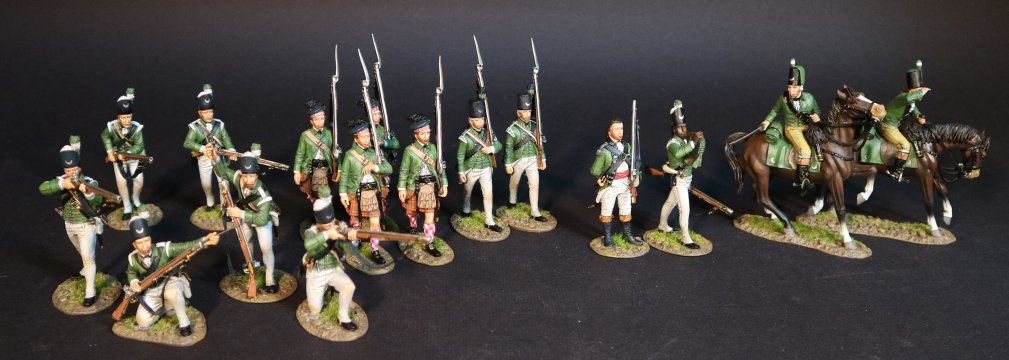
Following an inauspicious start when it was mauled by an American surprise attack at Mamaroneck in October 1776, it participated successfully in various campaigns throughout the Revolution until the surrender at Yorktown.
In a period of about a year, the Rangers had three commanding officers following Rogers. Major Christopher French reorganized the corps, during which process many officers and enlisted men were discharged. He was followed by Major James Wemyss in May 1777, under whom the unit increased in size and efficiency, participating in the Brunswick raid of June 1777. In the Battle of Brandywine, the command suffered the loss of one third of its number in killed or wounded, fourteen of twenty one commissioned officers were casualties.
Wemyss was wounded at the battle of Germantown. Major John Graves Simcoe succeeded him as commanding officer on October 15[SUP]th[/SUP], 1777.
It was under Simcoe that the Rangers reached the height of its efficiency. Starting as an infantry command, it gradually expanded and before its surrender at Yorktown consisted of eleven companies of foot, including riflemen, light infantry, grenadiers and a highland company, as well as dragoons, Hussars and some light guns.
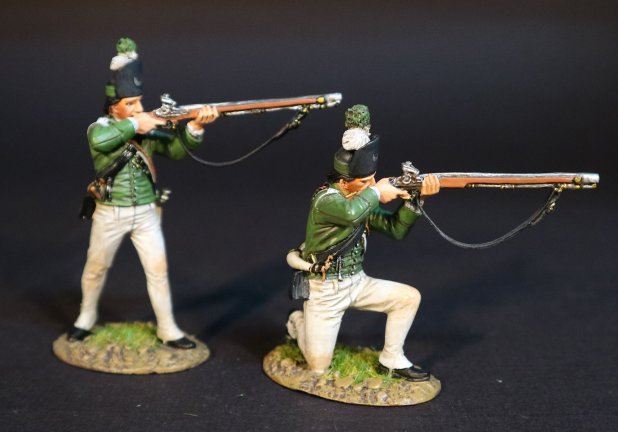
SQR-09
THE AMERICAN WAR OF INDEPENDENCE 1775 – 1783
THE BRITISH ARMY,
THE QUEEN’S RANGERS 1778-1783,
SIMCOE’S RANGERS,
LIGHT INFANTRY SKIRMISHING.
(2 pcs)
Simcoe had advanced ideas regarding training and discipline. He advocated constant vigilance, physical activity, and endurance of fatigue. There was constant instruction in marksmanship, the use of the bayonet, open formations, and the use of ambuscades. Units were trained to seldom return by their outgoing route. Officers were selected on their ability to perform such duties, and promotions when they occurred were from within the corps.
Regularity of messing and cleanliness were stressed, and officers were held responsible for the health of their men.
Written orders were avoided when possible, officers met after parade and received their orders verbally.
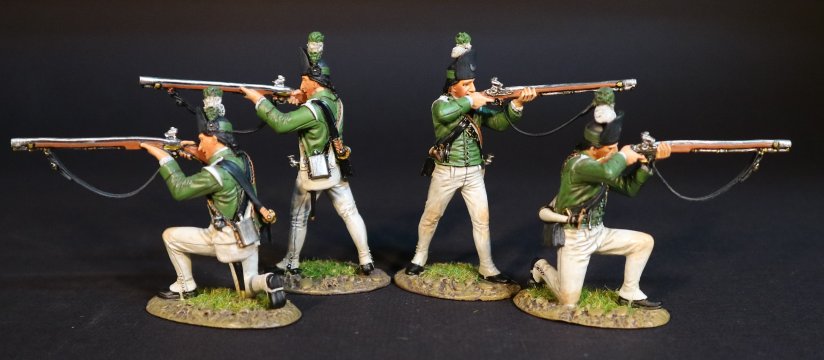
SQR-09N
THE AMERICAN WAR OF INDEPENDENCE 1775 – 1783
THE BRITISH ARMY,
THE QUEEN’S RANGERS 1778-1783,
SIMCOE’S RANGERS,
LIGHT INFANTRY SKIRMISHING.
(4 pcs)
After the war, the Rangers were removed to the British colony of Nova Scotia and disbanded.
** PLEASE CONTACT YOUR LOCAL DEALER FOR FURTHER INFORMATION**
THE EIGHTEENTH CENTURY COLLECTION
THE AMERICAN WAR OF INDEPENDENCE 1775 – 1783
THE BATTLE OF COWPENS, JANUARY 17[SUP]th[/SUP], 1781.
THE 7[SUP]th[/SUP] REGIMENT OF FOOT (ROYAL FUSILIERS.)
The Battle of Cowpens was an engagement during the American Revolutionary War fought on January 17[SUP]th[/SUP] 1781, near the town of Cowpens, South Carolina, between American forces under Brigadier General Daniel Morgan, and British forces under Lieutenant Colonel Banastre Tarleton, as part of the campaign in the Carolinas.
The battle was a turning point in the American reconquest of South Carolina from the British.
Tarleton’s force of 1,000 British troops were set against 2,000 troops under Morgan. Morgan’s forces suffered casualties of only 25 killed and 124 wounded. Tarleton’s force was almost completely eliminated with almost 30% casualties and 55% of his force captured or missing, with Tarleton himself and only about 200 British troops escaping.
Morgan’s forces conducted a double envelopment of the British forces, the only double envelopment of the war.

The Royal Fusiliers (city of London Regiment) was a line infantry regiment of the British Army which has been in continuous existence for 283 years. It was known as the 7[SUP]th[/SUP] Regiment of Foot until the Childers Reforms in 1881.
In 1747 the regiment was known as the Royal English Fuziliers and was given the precedence of 7[SUP]th[/SUP] in the Infantry of the Line. On 1[SUP]st[/SUP] July 1751 it was redesignated as the 7[SUP]th[/SUP] Regiment of Foot (Royal Fusiliers).
When county titles were added in August 1782 the subtitle (Derbyshire) was added, but this was never used and was later given to a different regiment.

CW7FL-05
THE AMERICAN WAR OF INDEPENDENCE 1775-1783,
THE BATTLE OF COWPENS, JANUARY 17[SUP]th[/SUP] 1781,
7[SUP]th[/SUP] REGIMENT OF FOOT (ROYAL FUSILIERS.)
(2 pcs)
The Royal Fusiliers were sent to Canada in April 1773. The regiment was broken up into detachments that served at Montreal, Quebec, Fort Chambly and Fort St. Johns. In the face of the American invasion of Canada in 1775/76, the 80 man garrison of Fort Chambly attempted to resist a 400 man Rebel force but ultimately had to surrender, losing its regimental colours as a result. The bulk of the regiment was captured when St. John’s fell.
A 70 man detachment under the command of Captain Humphrey Owens assisted with the Battle of Quebec in December 1775.
The men taken prisoner during the defence of Canada were exchanged in British held New York city in December 1776. Here the regiment was rebuilt and garrisoned New York and New Jersey. In October 1777, the 7[SUP]th[/SUP] participated in the successful assaults on Fort Clinton and Fort Montgomery and the destruction of enemy stores at Continental Village. In late November, 1777 the regiment reinforced the garrison of Philadelphia. During the British evacuation back to New York city, the regiment participated in a diversionary raid in the days leading up to the Battle of Monmouth in June 1778.
In April 1780, the Royal Fusiliers took part in the capture of Charleston. Once Charleston fell, the regiment helped garrison the city. Three companies were sent to Ninety-Six to assist with the training of Loyalist militia companies. An 80 man detachment was also sent to Camden, South Carolina to help build that town’s defences. The detachments were recalled to Charleston for refitting in late August 1780.
The 7[SUP]th[/SUP], mounted on horses, along with the two regiments of Loyalist militia, cleared the region north of Georgetown, South Carolina of partisans while en route. The Royal Fusiliers turned the horses over to Lieutenant Colonel Banastre Tarleton’s British Legion upon uniting with Cornwallis in late September and then served as the Army’s rearguard.

CW7FL-05N
THE AMERICAN WAR OF INDEPENDENCE 1775-1783,
THE BATTLE OF COWPENS, JANUARY 17[SUP]th[/SUP] 1781,
7[SUP]th[/SUP] REGIMENT OF FOOT (ROYAL FUSILIERS.)
(4 pcs)
Between October 1780 and early 1781, the regiment, having lost about one third of its officers and men to sickness and disease, protected the communication and supply lines between Camden and Winnsboro, South Carolina. On 7[SUP]th[/SUP] January, 1781, a contingent of 171 men from the Royal Fusiliers was detached from Cornwallis’s Army and fought under the command of Tarleton at the Battle of Cowpens in January 1781.
The Royal Fusiliers were on the left of the line of battle: Tarleton was defeated and the regiment’s colours were once again captured, and stored in the baggage wagons.
A 19 man detachment from the regiment fought through North Carolina participating in the Battle of Guilford Court House in March 1781 and ultimately the siege of Yorktown, where it served with the regiment’s Light Infantry Company. There was another detachment, composed largely of men recovered from the hospitals and recruits, which remained in the South under the command of Lt. Col. Alured Clarke. These men remained in garrison in Charleston, until they were transferred to Savannah, Georgia in December 1781.
The regiment returned to England in 1783.
THE QUEEN’S RANGERS (1[SUP]st[/SUP] AMERICAN REGIMENT) 1778-1783
SIMCOE’S RANGERS
The Queen’s Rangers came into being when Robert Rogers was authorized to raise a “Corps of Provincials” on August 16[SUP]th[/SUP] 1776. Recruited originally from Loyalists in New York and Connecticut, its men were farmers and city dwellers with little military experience.
They were a Loyalist military unit and were named for Queen Charlotte, consort of George III. The Queen’s Rangers served as a light corps in the tradition of British Rangers during the war, operating on the flanks and in advance of Crown forces, manning outposts, conducting patrols, and carrying out reconnaissance and raiding operations.

Following an inauspicious start when it was mauled by an American surprise attack at Mamaroneck in October 1776, it participated successfully in various campaigns throughout the Revolution until the surrender at Yorktown.
In a period of about a year, the Rangers had three commanding officers following Rogers. Major Christopher French reorganized the corps, during which process many officers and enlisted men were discharged. He was followed by Major James Wemyss in May 1777, under whom the unit increased in size and efficiency, participating in the Brunswick raid of June 1777. In the Battle of Brandywine, the command suffered the loss of one third of its number in killed or wounded, fourteen of twenty one commissioned officers were casualties.
Wemyss was wounded at the battle of Germantown. Major John Graves Simcoe succeeded him as commanding officer on October 15[SUP]th[/SUP], 1777.
It was under Simcoe that the Rangers reached the height of its efficiency. Starting as an infantry command, it gradually expanded and before its surrender at Yorktown consisted of eleven companies of foot, including riflemen, light infantry, grenadiers and a highland company, as well as dragoons, Hussars and some light guns.

SQR-09
THE AMERICAN WAR OF INDEPENDENCE 1775 – 1783
THE BRITISH ARMY,
THE QUEEN’S RANGERS 1778-1783,
SIMCOE’S RANGERS,
LIGHT INFANTRY SKIRMISHING.
(2 pcs)
Simcoe had advanced ideas regarding training and discipline. He advocated constant vigilance, physical activity, and endurance of fatigue. There was constant instruction in marksmanship, the use of the bayonet, open formations, and the use of ambuscades. Units were trained to seldom return by their outgoing route. Officers were selected on their ability to perform such duties, and promotions when they occurred were from within the corps.
Regularity of messing and cleanliness were stressed, and officers were held responsible for the health of their men.
Written orders were avoided when possible, officers met after parade and received their orders verbally.

SQR-09N
THE AMERICAN WAR OF INDEPENDENCE 1775 – 1783
THE BRITISH ARMY,
THE QUEEN’S RANGERS 1778-1783,
SIMCOE’S RANGERS,
LIGHT INFANTRY SKIRMISHING.
(4 pcs)
After the war, the Rangers were removed to the British colony of Nova Scotia and disbanded.
** PLEASE CONTACT YOUR LOCAL DEALER FOR FURTHER INFORMATION**

